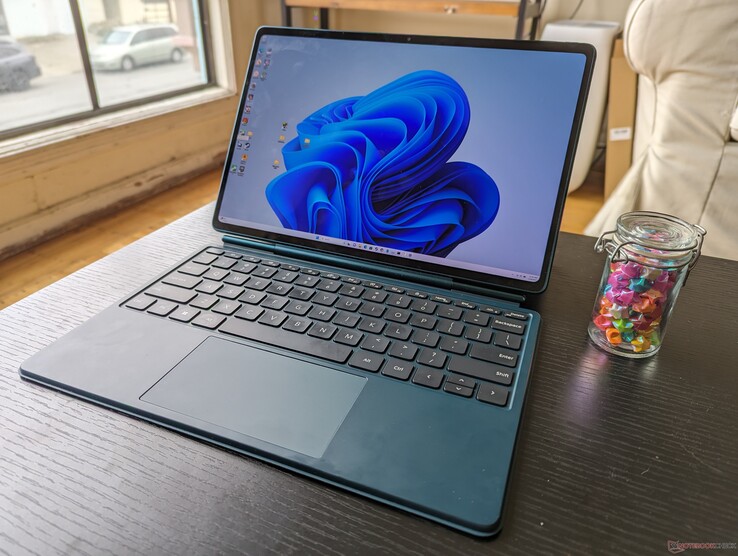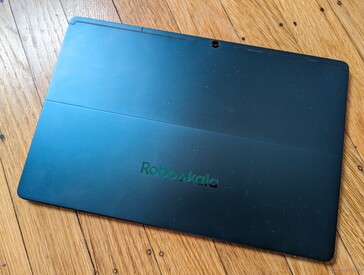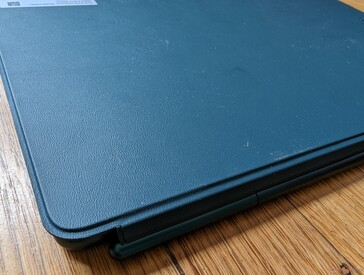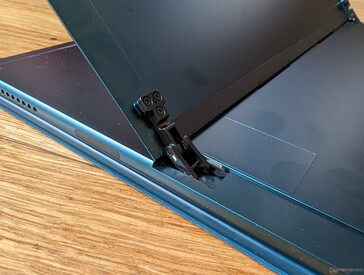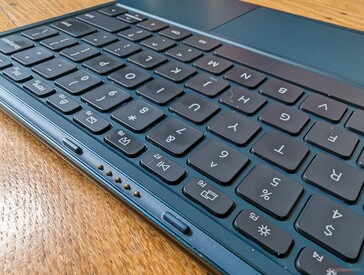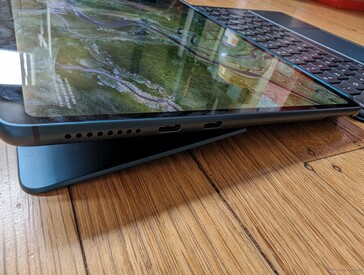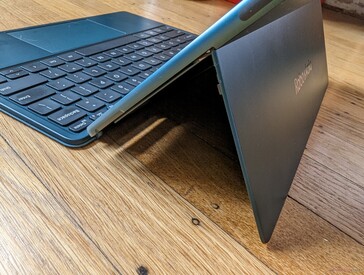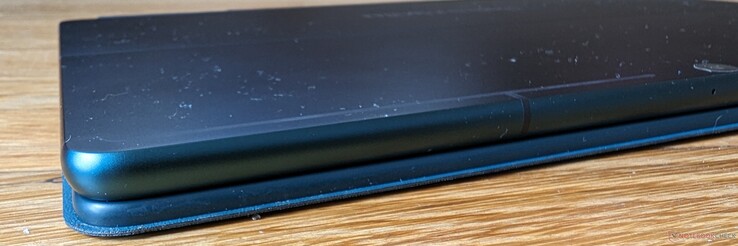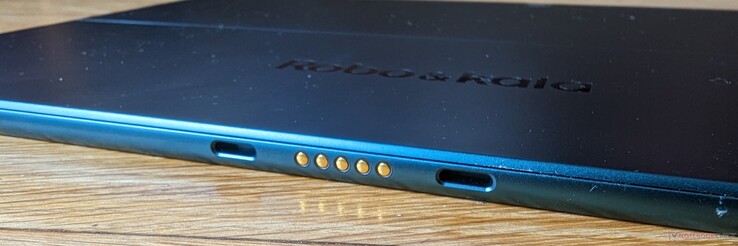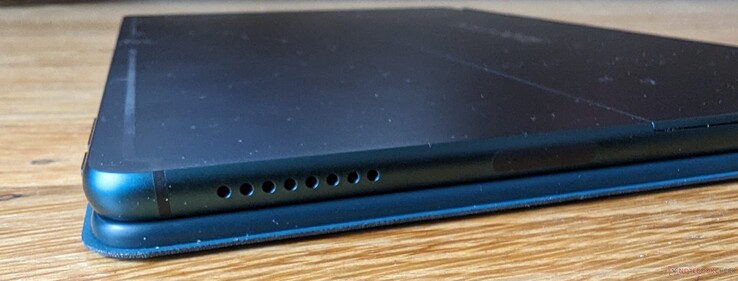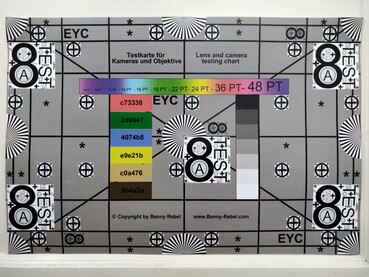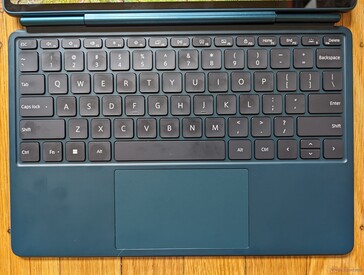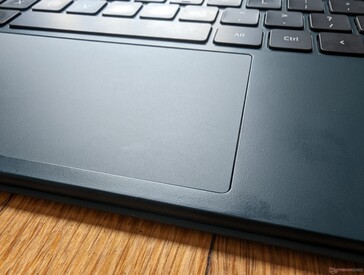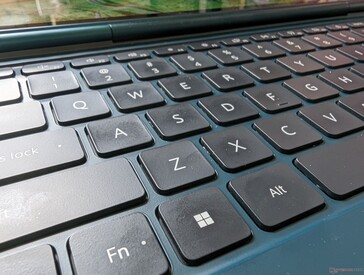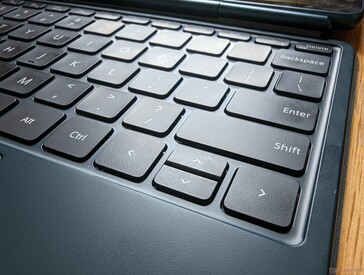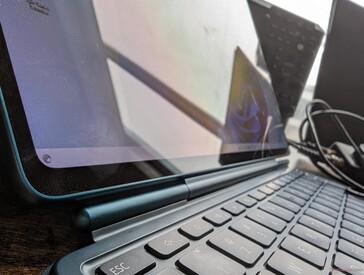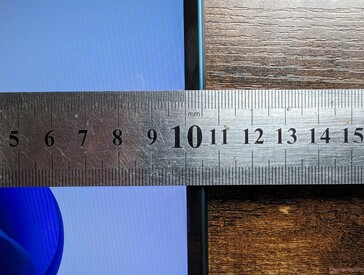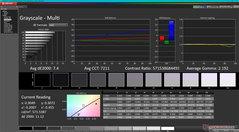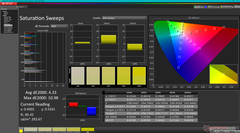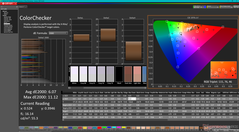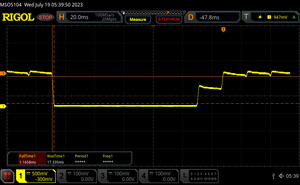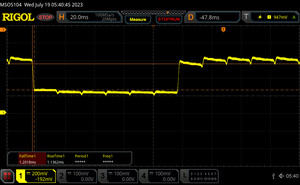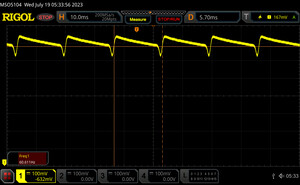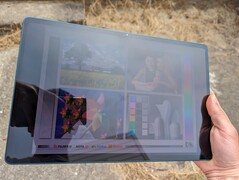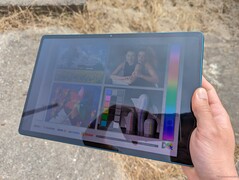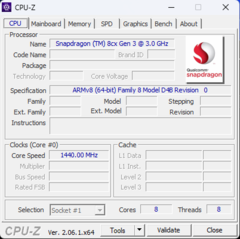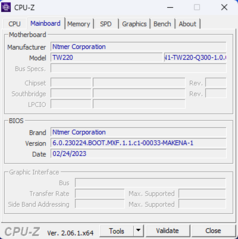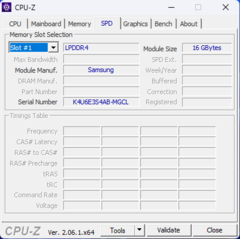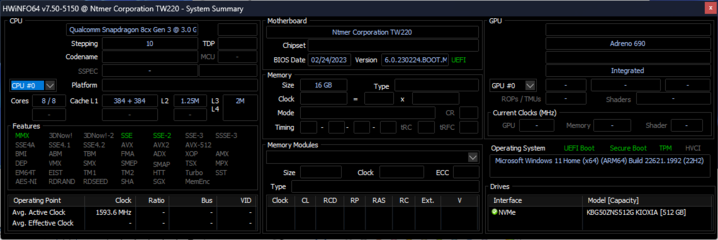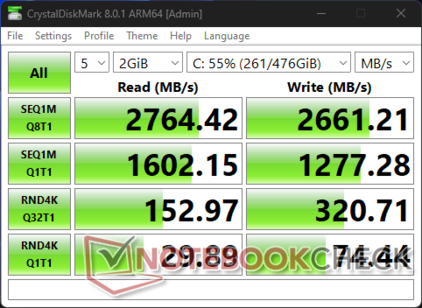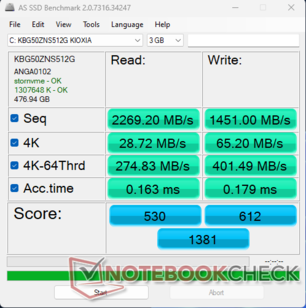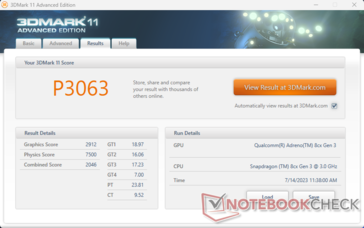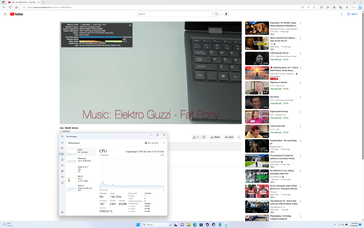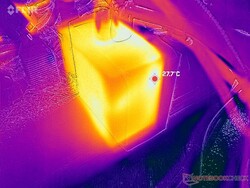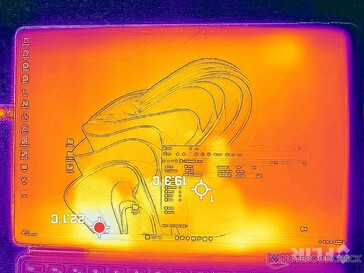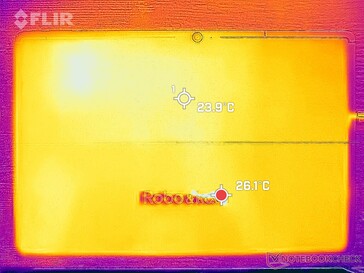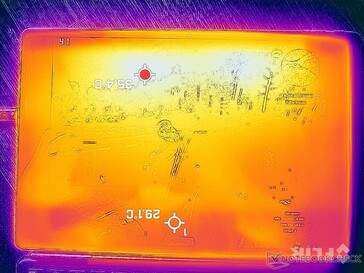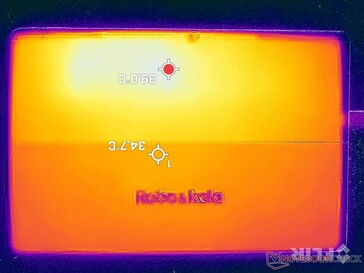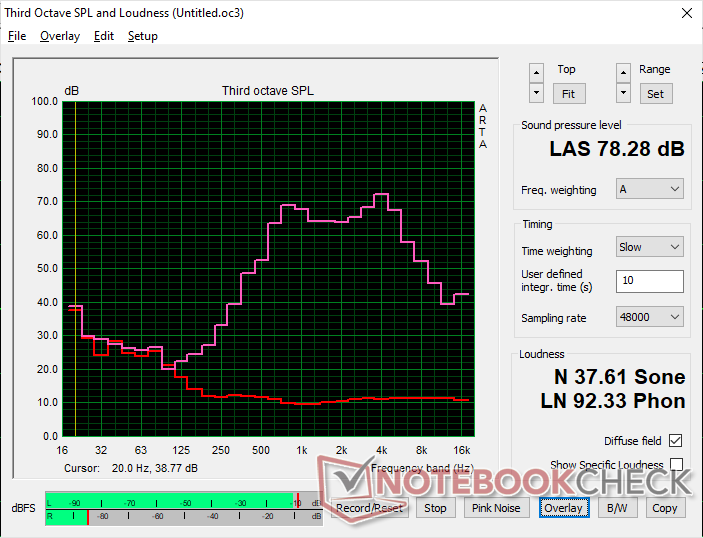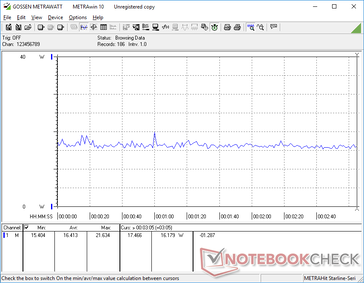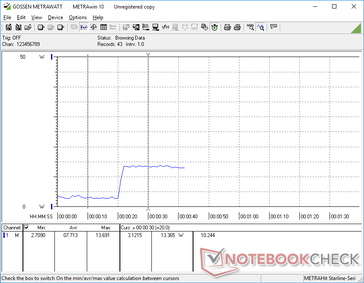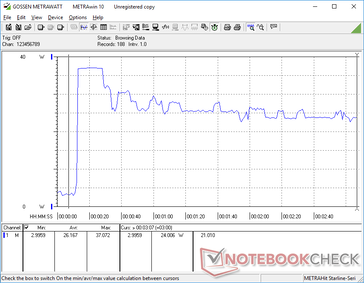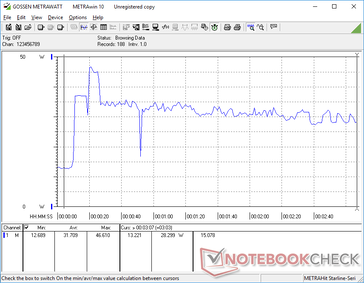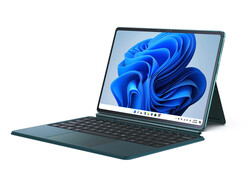Test de la Robo & Kala TW220 2-en-1 OLED : plus performante que la Microsoft Surface Go 3
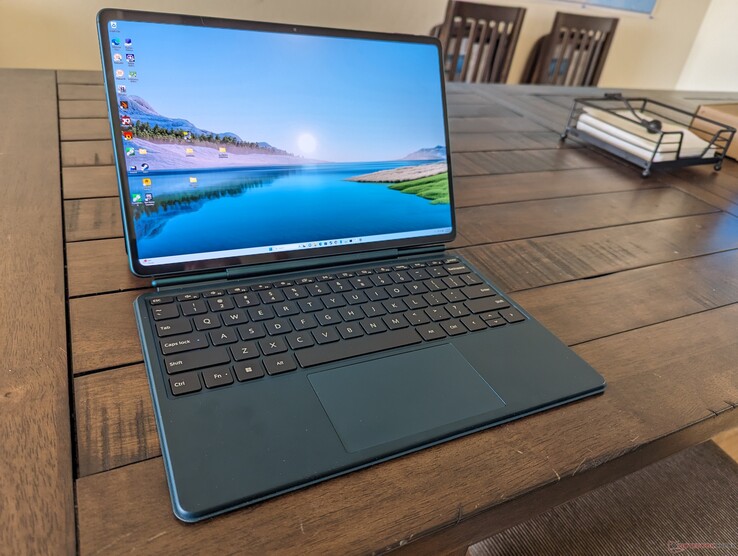
La TW220 est la dernière tablette phare sous Windows 11 de la société sino-américaine Robo et Kala. C'est l'une des rares tablettes Windows à être livrée avec un SoC ARM, et encore moins avec un SoC Qualcomm Qualcomm Snapdragon 8cx Gen 3 avec carte graphique Adreno 690 intégrée. En tant que telle, elle est en concurrence directe avec la gamme Surface de Microsoft, y compris la récente Surface Pro 9 ARM qui utilise exactement le même processeur Qualcomm.
Au-delà de son SoC peu commun, les spécifications ressemblent à celles d'une tablette haut de gamme, notamment l'écran tactile OLED 16:10 2560 x 1600 avec 98 % de couleurs DCI-P3, 16 Go de RAM LPDDR4X, 512 Go de SSD NVMe et une base de clavier détachable, le tout pour 599 USD, soit des centaines de dollars de moins qu'une Surface Pro typique équipée d'un processeur Core.
Comparaison avec les concurrents potentiels
Note | Date | Modèle | Poids | Épaisseur | Taille | Résolution | Prix |
|---|---|---|---|---|---|---|---|
| 82.1 % v7 (old) | 07/23 | Robo and Kala TW220 2-in-1 SD 8cx Gen 3, Adreno 690 | 712 g | 7.3 mm | 12.60" | 2560x1600 | |
| 88.4 % v7 (old) | 01/23 | Microsoft Surface Pro 9, i7-1255U i7-1255U, Iris Xe G7 96EUs | 877 g | 9.3 mm | 13.00" | 2880x1920 | |
| 86.9 % v7 (old) | 03/23 | Microsoft Surface Pro 9, ARM SD 8cx Gen 3, Adreno 690 | 883 g | 9.3 mm | 13.00" | 2880x1920 | |
| 85.3 % v7 (old) | 10/21 | Microsoft Surface Go 3 Core i3 i3-10100Y, UHD Graphics 615 | 783 g | 8.3 mm | 10.50" | 1920x1280 | |
| 88.6 % v7 (old) | 11/22 | Apple iPad 10 A14, A14 Bionic GPU | 477 g | 7 mm | 10.90" | 2360x1640 | |
| 92.5 % v7 (old) | 11/22 | Apple iPad Pro 11 2022 M2, M2 10-Core GPU | 466 g | 5.9 mm | 11.00" | 2388x1668 |
Top 10
» Le Top 10 des PC portables multimédia
» Le Top 10 des PC portables de jeu
» Le Top 10 des PC portables de jeu légers
» Le Top 10 des ordinateurs portables bureautiques
» Le Top 10 des PC portables bureautiques premium/professionnels
» Le Top 10 des Stations de travail mobiles
» Le Top 10 des Ultraportables
» Le Top 10 des Ultrabooks
» Le Top 10 des Convertibles
» Le Top 10 des Tablettes
» Le Top 10 des Tablettes Windows
» Le Top 10 des Smartphones
» Le Top 10 des PC Portables á moins de 300 euros
» Le Top 10 des PC Portables á moins de 500 euros
» Le Top 25 des meilleurs écrans d'ordinateurs
Cas - Une première impression forte
Le châssis en aluminium est rigide et donne une première impression de solidité, ce qui est impressionnant si l'on considère que la tablette est à la fois plus fine et plus légère que la Surface Pro et qu'elle présente des bords plus étroits. La base du clavier est également solide, mais ses broches de connexion se détachent trop facilement de la tablette.
La tablette elle-même pèse 712 g, tandis que la base du clavier ajoute 350 g, soit un total de 1,06 kg. Elle est plus légère que la plupart, voire tous les modèles Surface, y compris la plus petite, laSurface Go 3.
Connectivité
Les deux ports USB-C prennent chacun en charge le port d'affichage et la charge. Nous sommes en mesure de sortir jusqu'à un maximum de 4K et 60 Hz à une profondeur de couleur de 8 bits. Il n'y a pas de prise casque.
Communication
Un Qualcomm WCN685x est fourni en standard pour la connectivité Wi-Fi 6 et Wi-Fi 6E. Nous n'avons rencontré aucun problème lors de la connexion à notre réseau Asus AXE11000 6 GHz.
Webcam
Avec une résolution de 13 MP, la webcam de la TW220 est plus performante que celles de la Surface Pro 9 (10 MP) et de la Surface Go 3 (8 MP). L'infrarouge est intégré pour la prise en charge de Windows Hello, mais il n'y a pas d'obturateur de confidentialité.
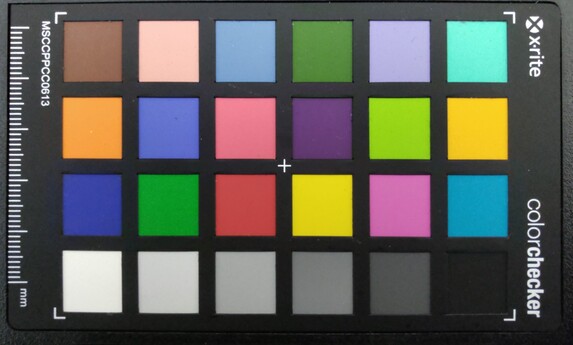
Accessoires et garantie
La boîte de vente au détail comprend une base de clavier amovible rétroéclairée et un stylo intelligent à 4096 niveaux de pression. La base du clavier dispose de sa propre batterie interne et peut se connecter à la tablette sans fil via Bluetooth ou physiquement via des broches de connexion. La base n'intègre aucun port et ne peut donc se recharger que lorsqu'elle est physiquement connectée à la tablette.
La garantie limitée standard d'un an du fabricant s'applique.
Dispositifs d'entrée
Clavier
Les claviers détachables des tablettes sont presque toujours moins bons que les claviers des ordinateurs portables traditionnels. Le clavier du TW220, cependant, n'est pas si mal. Le retour des touches est uniforme et net et la course de 1,3 mm est standard. Malheureusement, les touches sont un peu rigides et il faut donc plus d'effort aux doigts pour les enfoncer et enregistrer une entrée.
Pavé tactile
Le pavé tactile mesure 11 x 6,5 cm, ce qui est plus grand que le pavé tactile de 10,2 x 5,8 cm du clavier de la Surface Pro. Le retour d'information lors du clic est peu profond mais plus ferme que sur la plupart des ordinateurs portables. En revanche, les cliquetis sont nets et bruyants.
Écran - OLED
Le TW220 est le premier appareil de notre base de données à utiliser un écran OLED Sharp RM69380, contrairement aux écrans IPS LG Philips LP129WT2 ou BOE NV105WAM qui équipent laSurface Pro 9 ou Surface Go 3, respectivement. L'OLED présente des avantages inhérents par rapport à l'IPS, notamment des temps de réponse noir-blanc plus rapides pour réduire les images fantômes, des niveaux de noir plus profonds, des gammes de couleurs plus étendues et une meilleure uniformité de la luminosité.
| |||||||||||||||||||||||||
Homogénéité de la luminosité: 92 %
Valeur mesurée au centre, sur batterie: 568.7 cd/m²
Contraste: ∞:1 (Valeurs des noirs: 0 cd/m²)
ΔE ColorChecker Calman: 6.07 | ∀{0.5-29.43 Ø4.78}
ΔE Greyscale Calman: 7.4 | ∀{0.09-98 Ø5}
Gamma: 2.19
CCT: 7211 K
| Robo and Kala TW220 2-in-1 Sharp RM69380, AMOLED, 2560x1600, 12.6" | Microsoft Surface Pro 9, i7-1255U LP129WT2-SPA6, IPS, 2880x1920, 13" | Microsoft Surface Go 3 Core i3 NV105WAM-N31, IPS , 1920x1280, 10.5" | Apple iPad 10 Liquid Retina, IPS, 2360x1640, 10.9" | Apple iPad Pro 11 2022 IPS, 2388x1668, 11" | |
|---|---|---|---|---|---|
| Display | |||||
| Display P3 Coverage (%) | 65.6 | 69 | |||
| sRGB Coverage (%) | 97.7 | 99.1 | |||
| AdobeRGB 1998 Coverage (%) | 67.7 | 69.8 | |||
| Response Times | -647% | -1234% | -1336% | -1360% | |
| Response Time Grey 50% / Grey 80% * (ms) | 2.4 ? | 13 ? -442% | 37.2 ? -1450% | 42.68 ? -1678% | 43 ? -1692% |
| Response Time Black / White * (ms) | 2.04 ? | 19.4 ? -851% | 22.8 ? -1018% | 22.31 ? -994% | 23 ? -1027% |
| PWM Frequency (Hz) | 60.6 ? | 29896 ? | 962 ? | ||
| Screen | 30% | 30% | 30% | 38% | |
| Brightness middle (cd/m²) | 568.7 | 455 -20% | 418 -26% | 467 -18% | 620 9% |
| Brightness (cd/m²) | 573 | 453 -21% | 415 -28% | 468 -18% | 611 7% |
| Brightness Distribution (%) | 92 | 94 2% | 90 -2% | 92 0% | 93 1% |
| Black Level * (cd/m²) | 0.38 | 0.28 | 0.49 | 0.37 | |
| Colorchecker dE 2000 * | 6.07 | 1.7 72% | 1.2 80% | 1.4 77% | 1.49 75% |
| Colorchecker dE 2000 max. * | 11.12 | 3.8 66% | 2.6 77% | 3.3 70% | 3.67 67% |
| Greyscale dE 2000 * | 7.4 | 1.5 80% | 1.8 76% | 2.3 69% | 2.3 69% |
| Gamma | 2.19 100% | 2.17 101% | 2.21 100% | 2.21 100% | 2.211 100% |
| CCT | 7211 90% | 6761 96% | 6225 104% | 6852 95% | 6849 95% |
| Contrast (:1) | 1197 | 1493 | 953 | 1676 | |
| Colorchecker dE 2000 calibrated * | 1.5 | 1 | |||
| Moyenne finale (programmes/paramètres) | -309% /
-139% | -602% /
-286% | -653% /
-312% | -661% /
-311% |
* ... Moindre est la valeur, meilleures sont les performances
L'écran n'est pas pré-calibré bien qu'il s'agisse d'un panneau OLED de haute qualité. Il cible P3, mais la température de couleur trop froide signifie que les couleurs sont imprécises à des niveaux de saturation inférieurs, comme le montrent nos mesures CalMAN ci-dessous.
Temps de réponse de l'écran
| ↔ Temps de réponse noir à blanc | ||
|---|---|---|
| 2.04 ms ... hausse ↗ et chute ↘ combinées | ↗ 0.84 ms hausse | |
| ↘ 1.2 ms chute | ||
| L'écran montre de très faibles temps de réponse, parfait pour le jeu. En comparaison, tous les appareils testés affichent entre 0.1 (minimum) et 240 (maximum) ms. » 10 % des appareils testés affichent de meilleures performances. Cela signifie que les latences relevées sont meilleures que la moyenne (20.2 ms) de tous les appareils testés. | ||
| ↔ Temps de réponse gris 50% à gris 80% | ||
| 2.4 ms ... hausse ↗ et chute ↘ combinées | ↗ 1.2 ms hausse | |
| ↘ 1.2 ms chute | ||
| L'écran montre de très faibles temps de réponse, parfait pour le jeu. En comparaison, tous les appareils testés affichent entre 0.165 (minimum) et 636 (maximum) ms. » 10 % des appareils testés affichent de meilleures performances. Cela signifie que les latences relevées sont meilleures que la moyenne (31.6 ms) de tous les appareils testés. | ||
Scintillement / MLI (Modulation de largeur d'impulsion)
| Scintillement / MLI (Modulation de largeur d'impulsion) décelé | 60.6 Hz | ≤ 100 Niveau de luminosité | |
Le rétroéclairage de l'écran scintille à la fréquence de 60.6 Hz (certainement du fait de l'utilisation d'une MDI - Modulation de largeur d'impulsion) à un niveau de luminosité inférieur ou égal à 100 % . Aucun scintillement ne devrait être perceptible au-dessus de cette valeur. La fréquence de rafraîchissement de 60.6 Hz est extrêmement faible, de grands risques de fatigue oculaire accrue et de maux de tête en cas d'utilisation prolongée. En comparaison, 53 % des appareils testés n'emploient pas MDI pour assombrir leur écran. Nous avons relevé une moyenne à 8111 (minimum : 5 - maximum : 343500) Hz dans le cas où une MDI était active. | |||
Le scintillement est présent à tous les niveaux de luminosité, y compris à 100 %. Nous avons pu détecter un scintillement de 60 Hz, comme sur la plupart des tablettes, ordinateurs portables ou smartphones dotés d'écrans OLED.
L'écran de la Robo et de la Kala est en fait plus lumineux que les écrans de la Surface Pro 9 ou de la Surface Go 3 de 25 à 35 %. Il est néanmoins recommandé de travailler à l'ombre afin de réduire les reflets et de maximiser l'éclat des couleurs.
Performances - Plus rapide que le Core i3 dans les scénarios multithreads
Conditions d'essai
Nous avons réglé Windows sur le mode Performance avant d'exécuter les tests de référence ci-dessous. Il convient de noter que de nombreuses applications ne se lancent pas sous Windows ARM, y compris plusieurs de nos applications de référence habituelles. LatencyMon, PCMark 10, 3DMark, i1Profiler, BaseMark, Geekbench 5.4, GPUScore Sacred Path, 3DMark 06, HWiNFO sensor readings, et certains fichiers Windows Batch ne sont que quelques-unes des applications problématiques que nous avons rencontrées pendant les tests.
Processeur
Les performances multithread brutes sont toujours supérieures à celles du processeur Core i5-1035, vieux de trois ans.Core i5-1035G1 vieux de trois ans, alors que l'inverse est vrai pour les charges de travail à un seul thread. Les tâches exigeantes telles que l'encodage 4K ou Blender sont plus lentes que le Core i5, ce qui signifie que les utilisateurs puissants devraient toujours envisager une Microsoft Surface Pro Core i7. Au moins le Snapdragon 8cx Gen 3 est bien meilleur que l'ancienne série Core m3 sur la très lente Surface Go 2.
Sous Prime95, l'horloge du processeur atteignait 2,7 GHz pendant les premières secondes, avant de retomber et de se stabiliser à 2,1 GHz après quelques minutes.
Cinebench R15 Multi Loop (copy 1)
Cinebench R23: Multi Core | Single Core
Cinebench R20: CPU (Multi Core) | CPU (Single Core)
Cinebench R15: CPU Multi 64Bit | CPU Single 64Bit
Blender: v2.79 BMW27 CPU
7-Zip 18.03: 7z b 4 | 7z b 4 -mmt1
HWBOT x265 Benchmark v2.2: 4k Preset
LibreOffice : 20 Documents To PDF
R Benchmark 2.5: Overall mean
| Cinebench R23 / Multi Core | |
| Microsoft Surface Pro 9, i7-1255U | |
| Microsoft Surface Laptop 4 13 Ryzen 5 | |
| Microsoft Surface Pro 7 Plus | |
| Microsoft Surface Laptop Go 2 Core i5 | |
| Robo and Kala TW220 2-in-1 | |
| Moyenne Qualcomm Snapdragon 8cx Gen 3 (3534 - 3709, n=3) | |
| Microsoft Surface Pro 9, ARM | |
| Microsoft Surface Go 3 Core i3 | |
| Cinebench R23 / Single Core | |
| Microsoft Surface Pro 9, i7-1255U | |
| Microsoft Surface Laptop Go 2 Core i5 | |
| Microsoft Surface Pro 7 Plus | |
| Microsoft Surface Laptop 4 13 Ryzen 5 | |
| Microsoft Surface Go 3 Core i3 | |
| Microsoft Surface Pro 9, ARM | |
| Moyenne Qualcomm Snapdragon 8cx Gen 3 (559 - 608, n=3) | |
| Robo and Kala TW220 2-in-1 | |
Cinebench R23: Multi Core | Single Core
Cinebench R20: CPU (Multi Core) | CPU (Single Core)
Cinebench R15: CPU Multi 64Bit | CPU Single 64Bit
Blender: v2.79 BMW27 CPU
7-Zip 18.03: 7z b 4 | 7z b 4 -mmt1
HWBOT x265 Benchmark v2.2: 4k Preset
LibreOffice : 20 Documents To PDF
R Benchmark 2.5: Overall mean
* ... Moindre est la valeur, meilleures sont les performances
AIDA64: FP32 Ray-Trace | FPU Julia | CPU SHA3 | CPU Queen | FPU SinJulia | FPU Mandel | CPU AES | CPU ZLib | FP64 Ray-Trace | CPU PhotoWorxx
| AIDA64 / FP32 Ray-Trace | |
| Microsoft Surface Laptop 4 13 Ryzen 5 | |
| Microsoft Surface Pro 9, i7-1255U | |
| Microsoft Surface Pro 7 Plus | |
| Microsoft Surface Laptop Go 2 Core i5 | |
| Microsoft Surface Pro 9, ARM | |
| Robo and Kala TW220 2-in-1 | |
| Microsoft Surface Go 2, m3-8100Y | |
| Moyenne Qualcomm Snapdragon 8cx Gen 3 (343 - 2627, n=3) | |
| AIDA64 / FPU SinJulia | |
| Microsoft Surface Laptop 4 13 Ryzen 5 | |
| Microsoft Surface Pro 9, i7-1255U | |
| Microsoft Surface Pro 7 Plus | |
| Microsoft Surface Laptop Go 2 Core i5 | |
| Microsoft Surface Go 2, m3-8100Y | |
| Microsoft Surface Pro 9, ARM | |
| Moyenne Qualcomm Snapdragon 8cx Gen 3 (1161 - 1257, n=3) | |
| Robo and Kala TW220 2-in-1 | |
| AIDA64 / FPU Mandel | |
| Microsoft Surface Laptop 4 13 Ryzen 5 | |
| Microsoft Surface Pro 9, i7-1255U | |
| Microsoft Surface Pro 7 Plus | |
| Microsoft Surface Laptop Go 2 Core i5 | |
| Moyenne Qualcomm Snapdragon 8cx Gen 3 (7085 - 7704, n=3) | |
| Microsoft Surface Pro 9, ARM | |
| Robo and Kala TW220 2-in-1 | |
| Microsoft Surface Go 2, m3-8100Y | |
| AIDA64 / FP64 Ray-Trace | |
| Microsoft Surface Laptop 4 13 Ryzen 5 | |
| Microsoft Surface Pro 9, i7-1255U | |
| Microsoft Surface Pro 7 Plus | |
| Microsoft Surface Laptop Go 2 Core i5 | |
| Microsoft Surface Pro 9, ARM | |
| Robo and Kala TW220 2-in-1 | |
| Microsoft Surface Go 2, m3-8100Y | |
| Moyenne Qualcomm Snapdragon 8cx Gen 3 (204 - 1379, n=3) | |
| AIDA64 / CPU PhotoWorxx | |
| Microsoft Surface Pro 9, i7-1255U | |
| Microsoft Surface Pro 7 Plus | |
| Microsoft Surface Laptop Go 2 Core i5 | |
| Microsoft Surface Laptop 4 13 Ryzen 5 | |
| Robo and Kala TW220 2-in-1 | |
| Microsoft Surface Go 2, m3-8100Y | |
| Microsoft Surface Pro 9, ARM | |
| Moyenne Qualcomm Snapdragon 8cx Gen 3 (7622 - 14660, n=3) | |
AIDA64: FP32 Ray-Trace | FPU Julia | CPU SHA3 | CPU Queen | FPU SinJulia | FPU Mandel | CPU AES | CPU ZLib | FP64 Ray-Trace | CPU PhotoWorxx
Performance du système
D'un point de vue subjectif, Windows 11 fonctionne de manière fluide et réactive sur le SoC Snapdragon et nous n'avons pas rencontré de BSOD pendant les tests. Cela dit, il faut garder à l'esprit que la plupart des applications sont exécutées via l'émulation et que les risques d'incompatibilité sont donc élevés.
La navigation dans le système d'exploitation n'est pas aussi fluide que sur la plupart des tablettes Android, en partie à cause du taux de rafraîchissement de 60 Hz de l'écran. De nos jours, la plupart des tablettes sont déjà passées à des taux de rafraîchissement plus élevés, comme l'écran 120 Hz de la tablette Lenovo P11.
| CrossMark / Overall | |
| Microsoft Surface Pro 9, i7-1255U | |
| Microsoft Surface Laptop Go 2 Core i5 | |
| Microsoft Surface Duo 2 | |
| Moyenne Qualcomm Snapdragon 8cx Gen 3, Qualcomm Adreno 690 (627 - 718, n=2) | |
| Robo and Kala TW220 2-in-1 | |
| CrossMark / Productivity | |
| Microsoft Surface Pro 9, i7-1255U | |
| Microsoft Surface Laptop Go 2 Core i5 | |
| Microsoft Surface Duo 2 | |
| Moyenne Qualcomm Snapdragon 8cx Gen 3, Qualcomm Adreno 690 (586 - 685, n=2) | |
| Robo and Kala TW220 2-in-1 | |
| CrossMark / Creativity | |
| Microsoft Surface Pro 9, i7-1255U | |
| Microsoft Surface Laptop Go 2 Core i5 | |
| Microsoft Surface Duo 2 | |
| Moyenne Qualcomm Snapdragon 8cx Gen 3, Qualcomm Adreno 690 (740 - 776, n=2) | |
| Robo and Kala TW220 2-in-1 | |
| CrossMark / Responsiveness | |
| Microsoft Surface Pro 9, i7-1255U | |
| Microsoft Surface Duo 2 | |
| Microsoft Surface Laptop Go 2 Core i5 | |
| Moyenne Qualcomm Snapdragon 8cx Gen 3, Qualcomm Adreno 690 (468 - 652, n=2) | |
| Robo and Kala TW220 2-in-1 | |
| AIDA64 / Memory Copy | |
| Microsoft Surface Pro 9, i7-1255U | |
| Microsoft Surface Pro 7 Plus | |
| Microsoft Surface Laptop Go 2 Core i5 | |
| Robo and Kala TW220 2-in-1 | |
| Moyenne Qualcomm Snapdragon 8cx Gen 3 (40599 - 42710, n=3) | |
| Microsoft Surface Pro 9, ARM | |
| Microsoft Surface Laptop 4 13 Ryzen 5 | |
| Microsoft Surface Go 2, m3-8100Y | |
| AIDA64 / Memory Read | |
| Microsoft Surface Pro 9, i7-1255U | |
| Microsoft Surface Pro 7 Plus | |
| Microsoft Surface Laptop Go 2 Core i5 | |
| Microsoft Surface Laptop 4 13 Ryzen 5 | |
| Robo and Kala TW220 2-in-1 | |
| Moyenne Qualcomm Snapdragon 8cx Gen 3 (33013 - 33757, n=3) | |
| Microsoft Surface Pro 9, ARM | |
| Microsoft Surface Go 2, m3-8100Y | |
| AIDA64 / Memory Write | |
| Microsoft Surface Pro 7 Plus | |
| Microsoft Surface Pro 9, i7-1255U | |
| Microsoft Surface Laptop Go 2 Core i5 | |
| Microsoft Surface Pro 9, ARM | |
| Robo and Kala TW220 2-in-1 | |
| Moyenne Qualcomm Snapdragon 8cx Gen 3 (49100 - 49815, n=3) | |
| Microsoft Surface Laptop 4 13 Ryzen 5 | |
| Microsoft Surface Go 2, m3-8100Y | |
* ... Moindre est la valeur, meilleures sont les performances
Dispositifs de stockage
Le système est livré avec un Toshiba Kioxia BG5 KBG50ZNS512G qui est un SSD NVMe PCIe4 x4 économique. Le disque peut soutenir des taux de lecture d'un peu plus de 2000 Mo/s même après un stress prolongé.
* ... Moindre est la valeur, meilleures sont les performances
Disk Throttling: DiskSpd Read Loop, Queue Depth 8
Performance du GPU
Les utilisateurs ne doivent pas s'attendre à ce que le système intégré Adreno 690 soit plus performante que celle d'un Iris Xe ou Radeon RX Vega puisqu'il fonctionne avec une enveloppe énergétique plus faible et qu'il est refroidi passivement. Malgré cela, 3DMark 11 révèle que le GPU Qualcomm est au moins plus rapide que les très anciens GPU de la série Iris Xe et Radeon RX Vega UHD Graphics série. Plus important encore, la tablette est capable de lire des vidéos 4K à 60 FPS sans aucune perte d'images.
| 3DMark 11 Performance | 3063 points | |
Aide | ||
| Blender - v3.3 Classroom CPU | |
| Robo and Kala TW220 2-in-1 | |
| Microsoft Surface Laptop Go 2 Core i5 | |
| Microsoft Surface Pro 9, i7-1255U | |
* ... Moindre est la valeur, meilleures sont les performances
Performance des jeux
Le TW220 est plus adapté au streaming de jeux qu'au jeu natif. Cela dit, les performances de jeu se situent entre les cartes plus lentes UHD Graphics et les cartes plus rapides Iris Xe 80 EU que l'on trouve sur la plupart des ordinateurs portables Core i5. De toute façon, de nombreux jeux ne se lanceraient pas ou se bloqueraient avec certains paramètres.
| GTA V | |
| 1024x768 Lowest Settings possible | |
| Microsoft Surface Pro 9, i7-1255U | |
| Robo and Kala TW220 2-in-1 | |
| Moyenne Qualcomm Adreno 690 (n=1) | |
| 1920x1080 Lowest Settings possible | |
| Robo and Kala TW220 2-in-1 | |
| Moyenne Qualcomm Adreno 690 (n=1) | |
| The Witcher 3 | |
| 1024x768 Low Graphics & Postprocessing | |
| Microsoft Surface Pro 9, i7-1255U | |
| Microsoft Surface Pro 7 Plus | |
| Microsoft Surface Laptop 4 13 Ryzen 5 | |
| Microsoft Surface Laptop Go 2 Core i5 | |
| Robo and Kala TW220 2-in-1 | |
| Moyenne Qualcomm Adreno 690 (35 - 38.6, n=2) | |
| Microsoft Surface Pro 9, ARM | |
| Microsoft Surface Go 2, m3-8100Y | |
| Microsoft Surface Go 3 Core i3 | |
| 1366x768 Medium Graphics & Postprocessing | |
| Microsoft Surface Pro 9, i7-1255U | |
| Microsoft Surface Pro 7 Plus | |
| Microsoft Surface Laptop 4 13 Ryzen 5 | |
| Microsoft Surface Laptop Go 2 Core i5 | |
| Robo and Kala TW220 2-in-1 | |
| Moyenne Qualcomm Adreno 690 (n=1) | |
| 1920x1080 High Graphics & Postprocessing (Nvidia HairWorks Off) | |
| Microsoft Surface Pro 9, i7-1255U | |
| Microsoft Surface Pro 7 Plus | |
| Robo and Kala TW220 2-in-1 | |
| Moyenne Qualcomm Adreno 690 (n=1) | |
| Microsoft Surface Laptop 4 13 Ryzen 5 | |
| 1920x1080 Ultra Graphics & Postprocessing (HBAO+) | |
| Microsoft Surface Pro 7 Plus | |
| Microsoft Surface Pro 9, i7-1255U | |
| Robo and Kala TW220 2-in-1 | |
| Moyenne Qualcomm Adreno 690 (n=1) | |
| F1 22 | |
| 1280x720 Ultra Low Preset AA:T AF:16x | |
| Robo and Kala TW220 2-in-1 | |
| Moyenne Qualcomm Adreno 690 (n=1) | |
| 1920x1080 Low Preset AA:T AF:16x | |
| Microsoft Surface Pro 9, i7-1255U | |
| Robo and Kala TW220 2-in-1 | |
| Moyenne Qualcomm Adreno 690 (n=1) | |
| 1920x1080 Medium Preset AA:T AF:16x | |
| Microsoft Surface Pro 9, i7-1255U | |
| Robo and Kala TW220 2-in-1 | |
| Moyenne Qualcomm Adreno 690 (n=1) | |
| 1920x1080 High Preset AA:T AF:16x | |
| Microsoft Surface Pro 9, i7-1255U | |
| Robo and Kala TW220 2-in-1 | |
| Moyenne Qualcomm Adreno 690 (n=1) | |
| 1920x1080 Ultra High Preset AA:T AF:16x | |
| Robo and Kala TW220 2-in-1 | |
| Moyenne Qualcomm Adreno 690 (n=1) | |
Witcher 3 FPS Chart
| Bas | Moyen | Élevé | Ultra | |
|---|---|---|---|---|
| GTA V (2015) | 29.9 | |||
| The Witcher 3 (2015) | 38.6 | 31.5 | 19.1 | 8.5 |
| Dota 2 Reborn (2015) | 58.7 | 55.2 | 45.9 | 40.2 |
| Final Fantasy XV Benchmark (2018) | 19 | 12.3 | 7.29 | |
| X-Plane 11.11 (2018) | 21.3 | 18.9 | 16.1 | |
| F1 22 (2022) | 26 | 22.5 | 17 | 12.6 |
Émissions
Température
La température de la surface peut devenir très élevée, mais pas aussi élevée que celle de la Surface Pro 9. Les points chauds peuvent atteindre jusqu'à 36 C et 40 C à l'avant et à l'arrière, respectivement, contre 45 C de chaque côté de la tablette de Microsoft.
(+) La température maximale du côté supérieur est de 39.4 °C / 103 F, par rapport à la moyenne de 33.7 °C / 93 F, allant de 20.7 à 53.2 °C pour la classe Tablet.
(±) Le fond chauffe jusqu'à un maximum de 40.8 °C / 105 F, contre une moyenne de 33.2 °C / 92 F
(+) En utilisation inactive, la température moyenne du côté supérieur est de 26.2 °C / 79 F, par rapport à la moyenne du dispositif de 30 °C / 86 F.
| Robo and Kala TW220 2-in-1 Qualcomm Snapdragon 8cx Gen 3, Qualcomm Adreno 690 | Microsoft Surface Pro 9, i7-1255U Intel Core i7-1255U, Intel Iris Xe Graphics G7 96EUs | Microsoft Surface Pro 9, ARM Qualcomm Snapdragon 8cx Gen 3, Qualcomm Adreno 690 | Microsoft Surface Go 3 Core i3 Intel Core i3-10100Y, Intel UHD Graphics 615 | Apple iPad 10 Apple A14 Bionic, Apple A14 Bionic GPU | Apple iPad Pro 11 2022 Apple M2, Apple M2 10-Core GPU | |
|---|---|---|---|---|---|---|
| Heat | -3% | 5% | -2% | -7% | 14% | |
| Maximum Upper Side * (°C) | 39.4 | 44.6 -13% | 40.8 -4% | 46.1 -17% | 35.1 11% | 34.3 13% |
| Maximum Bottom * (°C) | 40.8 | 45.9 -13% | 43.4 -6% | 42.7 -5% | 36.9 10% | 34.5 15% |
| Idle Upper Side * (°C) | 26.8 | 24.8 7% | 23.2 13% | 25 7% | 33.4 -25% | 22.8 15% |
| Idle Bottom * (°C) | 26.8 | 25.3 6% | 22.6 16% | 25 7% | 33.1 -24% | 23.1 14% |
* ... Moindre est la valeur, meilleures sont les performances
Intervenants
Robo and Kala TW220 2-in-1 analyse audio
(±) | le niveau sonore du haut-parleur est moyen mais bon (78.3# dB)
Basses 100 - 315 Hz
(-) | presque aucune basse - en moyenne 24.9% plus bas que la médiane
(±) | la linéarité des basses est moyenne (10.5% delta à la fréquence précédente)
Médiums 400 - 2000 Hz
(±) | médiane supérieure - en moyenne 10.1% supérieure à la médiane
(±) | la linéarité des médiums est moyenne (10.5% delta à la fréquence précédente)
Aiguës 2 - 16 kHz
(±) | sommets plus élevés - en moyenne 10.7% plus élevés que la médiane
(±) | la linéarité des aigus est moyenne (12% delta à la fréquence précédente)
Globalement 100 - 16 000 Hz
(-) | le son global n'est pas linéaire (35.9% de différence à la médiane)
Par rapport à la même classe
» 96% de tous les appareils testés de cette catégorie étaient meilleurs, 2% similaires, 3% pires
» Le meilleur avait un delta de 7%, la moyenne était de 20%, le pire était de 129%.
Par rapport à tous les appareils testés
» 94% de tous les appareils testés étaient meilleurs, 1% similaires, 6% pires
» Le meilleur avait un delta de 4%, la moyenne était de 24%, le pire était de 134%.
Apple MacBook Pro 16 2021 M1 Pro analyse audio
(+) | les haut-parleurs peuvent jouer relativement fort (84.7# dB)
Basses 100 - 315 Hz
(+) | bonne basse - seulement 3.8% loin de la médiane
(+) | les basses sont linéaires (5.2% delta à la fréquence précédente)
Médiums 400 - 2000 Hz
(+) | médiane équilibrée - seulement 1.3% de la médiane
(+) | les médiums sont linéaires (2.1% delta à la fréquence précédente)
Aiguës 2 - 16 kHz
(+) | des sommets équilibrés - à seulement 1.9% de la médiane
(+) | les aigus sont linéaires (2.7% delta à la fréquence précédente)
Globalement 100 - 16 000 Hz
(+) | le son global est linéaire (4.6% différence à la médiane)
Par rapport à la même classe
» 0% de tous les appareils testés de cette catégorie étaient meilleurs, 0% similaires, 100% pires
» Le meilleur avait un delta de 5%, la moyenne était de 17%, le pire était de 45%.
Par rapport à tous les appareils testés
» 0% de tous les appareils testés étaient meilleurs, 0% similaires, 100% pires
» Le meilleur avait un delta de 4%, la moyenne était de 24%, le pire était de 134%.
Gestion de l'énergie
Consommation électrique
La consommation globale est légèrement supérieure à celle de la Surface Go 3, tout en étant bien inférieure à celle de la Surface Pro 9, équipée d'un Core i7 plus rapide. L'écran tactile OLED est nettement plus gourmand en énergie, puisqu'il peut à lui seul consommer jusqu'à 9 W en fonction de la couleur et de la luminosité choisies. Il peut offrir des couleurs plus profondes et un rétroéclairage plus lumineux qu'un modèle Surface, mais les propriétaires en paient le prix avec une consommation d'énergie plus élevée.
| Éteint/en veille | |
| Au repos | |
| Fortement sollicité |
|
Légende:
min: | |
| Robo and Kala TW220 2-in-1 SD 8cx Gen 3, Adreno 690, Kioxia BG5 KBG50ZNS512G, AMOLED, 2560x1600, 12.6" | Microsoft Surface Pro 9, i7-1255U i7-1255U, Iris Xe G7 96EUs, Samsung MZ9L4512HBLU-00BMV, IPS, 2880x1920, 13" | Microsoft Surface Pro 9, ARM SD 8cx Gen 3, Adreno 690, , IPS, 2880x1920, 13" | Microsoft Surface Go 3 Core i3 i3-10100Y, UHD Graphics 615, SK hynix HFB1M8MQ331C0MR, IPS , 1920x1280, 10.5" | Apple iPad 10 A14, A14 Bionic GPU, 64 GB SSD, IPS, 2360x1640, 10.9" | Apple iPad Pro 11 2022 M2, M2 10-Core GPU, 128 GB NVMe, IPS, 2388x1668, 11" | |
|---|---|---|---|---|---|---|
| Power Consumption | -59% | 13% | 30% | 46% | 55% | |
| Idle Minimum * (Watt) | 3.2 | 5.1 -59% | 2.8 12% | 2.6 19% | 1.34 58% | 1.1 66% |
| Idle Average * (Watt) | 6.7 | 9.8 -46% | 6.8 -1% | 5.1 24% | 7.78 -16% | 6 10% |
| Idle Maximum * (Watt) | 15.3 | 11.3 26% | 8.1 47% | 5.9 61% | 7.89 48% | 6.1 60% |
| Load Average * (Watt) | 22.7 | 47.5 -109% | 23.8 -5% | 22.9 -1% | 9.05 60% | 9.1 60% |
| Witcher 3 ultra * (Watt) | 16.4 | 36 -120% | ||||
| Load Maximum * (Watt) | 46.7 | 68.5 -47% | 40.2 14% | 24.6 47% | 9.98 79% | 10.2 78% |
* ... Moindre est la valeur, meilleures sont les performances
Power Consumption Witcher 3 / Stresstest
Power Consumption external Monitor
Autonomie de la batterie
La capacité de la batterie est inférieure à celle de la série Surface Pro (41 Wh), mais l'autonomie est tout aussi bonne, avec 8,5 heures de navigation sur le web en conditions réelles.
Le chargement de la batterie vide à la pleine capacité prend environ 70 minutes avec l'adaptateur secteur USB-C 65 W inclus (~5,3 x 5,3 x 3 cm).
| Robo and Kala TW220 2-in-1 SD 8cx Gen 3, Adreno 690, 41 Wh | Microsoft Surface Pro 9, i7-1255U i7-1255U, Iris Xe G7 96EUs, 47.7 Wh | Microsoft Surface Pro 9, ARM SD 8cx Gen 3, Adreno 690, 47.7 Wh | Microsoft Surface Go 3 Core i3 i3-10100Y, UHD Graphics 615, 28 Wh | Apple iPad 10 A14, A14 Bionic GPU, 28.93 Wh | Apple iPad Pro 11 2022 M2, M2 10-Core GPU, 28.65 Wh | |
|---|---|---|---|---|---|---|
| Autonomie de la batterie | -23% | 17% | -19% | 34% | 75% | |
| Reader / Idle (h) | 23.4 | 28.8 23% | 36.6 56% | |||
| WiFi v1.3 (h) | 8.6 | 7.5 -13% | 10.1 17% | 7 -19% | 10.8 26% | 14.1 64% |
| Load (h) | 2.1 | 1.4 -33% | 3.2 52% | 4.3 105% | ||
| H.264 (h) | 9.4 | 12.3 | 15.7 |
Points positifs
Points négatifs
Verdict - Un excellent compromis entre la Surface Pro et la Surface Go
Les meilleurs aspects du Robo and Kala TW220 sont son écran tactile OLED, ses performances ARM décentes et son prix relativement abordable pour un châssis en aluminium et une base de clavier bien construits. L'écran OLED en particulier aide à différencier le TW220 des séries concurrentes Surface Pro et Surface Go et c'est un point fort du modèle. Les utilisateurs qui peuvent apprécier ou exploiter les couleurs plus larges et les niveaux de noir plus profonds de l'OLED trouveront la TW220 plus intéressante que la plupart des autres tablettes Windows.
Si vous pouvez supporter les limitations de Windows ARM, la Robo and Kala TW220 serait une alternative abordable à la Surface Go 3 ou même à la Surface Pro 9 si vous n'avez pas besoin de la puissance d'un Intel Core i7.
Pour les futurs modèles, nous aimerions que l'écran soit pré-calibré afin que les propriétaires puissent profiter de couleurs OLED précises dès la sortie de la boîte. Les broches de connexion du clavier pourraient être plus solides et des options de connectivité supplémentaires seraient appréciées, notamment des options MicroSD ou LTE/5G. Certains problèmes de compatibilité sont inévitables avec ARM et un modèle alternatif avec des CPU Intel Core pourrait attirer un plus grand nombre d'acheteurs intéressés. Pour les tâches de base telles que la navigation, l'envoi d'e-mails et le streaming, la TW220 est l'une des tablettes Windows les plus efficaces que nous ayons vues pour son prix, surtout si on la compare aux tablettes plus petites de la série Surface Go Surface Go.
Prix et disponibilité
Le Robo & Kala TW220 est maintenant disponible sur le site officiel au prix de $599 USD ou sur Amazon au même prix après application d'un code de réduction pour $599 USD ou sur Amazon pour le même prix après application du code de réduction.
Robo and Kala TW220 2-in-1
- 07/20/2023 v7 (old)
Allen Ngo
Transparency
La sélection des appareils à examiner est effectuée par notre équipe éditoriale. L'échantillon de test a été prêté à l'auteur par le fabricant ou le détaillant pour les besoins de cet examen. Le prêteur n'a pas eu d'influence sur cette évaluation et le fabricant n'a pas reçu de copie de cette évaluation avant sa publication. Il n'y avait aucune obligation de publier cet article. En tant que média indépendant, Notebookcheck n'est pas soumis à l'autorité des fabricants, des détaillants ou des éditeurs.
Voici comment Notebookcheck teste
Chaque année, Notebookcheck examine de manière indépendante des centaines d'ordinateurs portables et de smartphones en utilisant des procédures standardisées afin de garantir que tous les résultats sont comparables. Nous avons continuellement développé nos méthodes de test depuis environ 20 ans et avons établi des normes industrielles dans le processus. Dans nos laboratoires de test, des équipements de mesure de haute qualité sont utilisés par des techniciens et des rédacteurs expérimentés. Ces tests impliquent un processus de validation en plusieurs étapes. Notre système d'évaluation complexe repose sur des centaines de mesures et de points de référence bien fondés, ce qui garantit l'objectivité.



